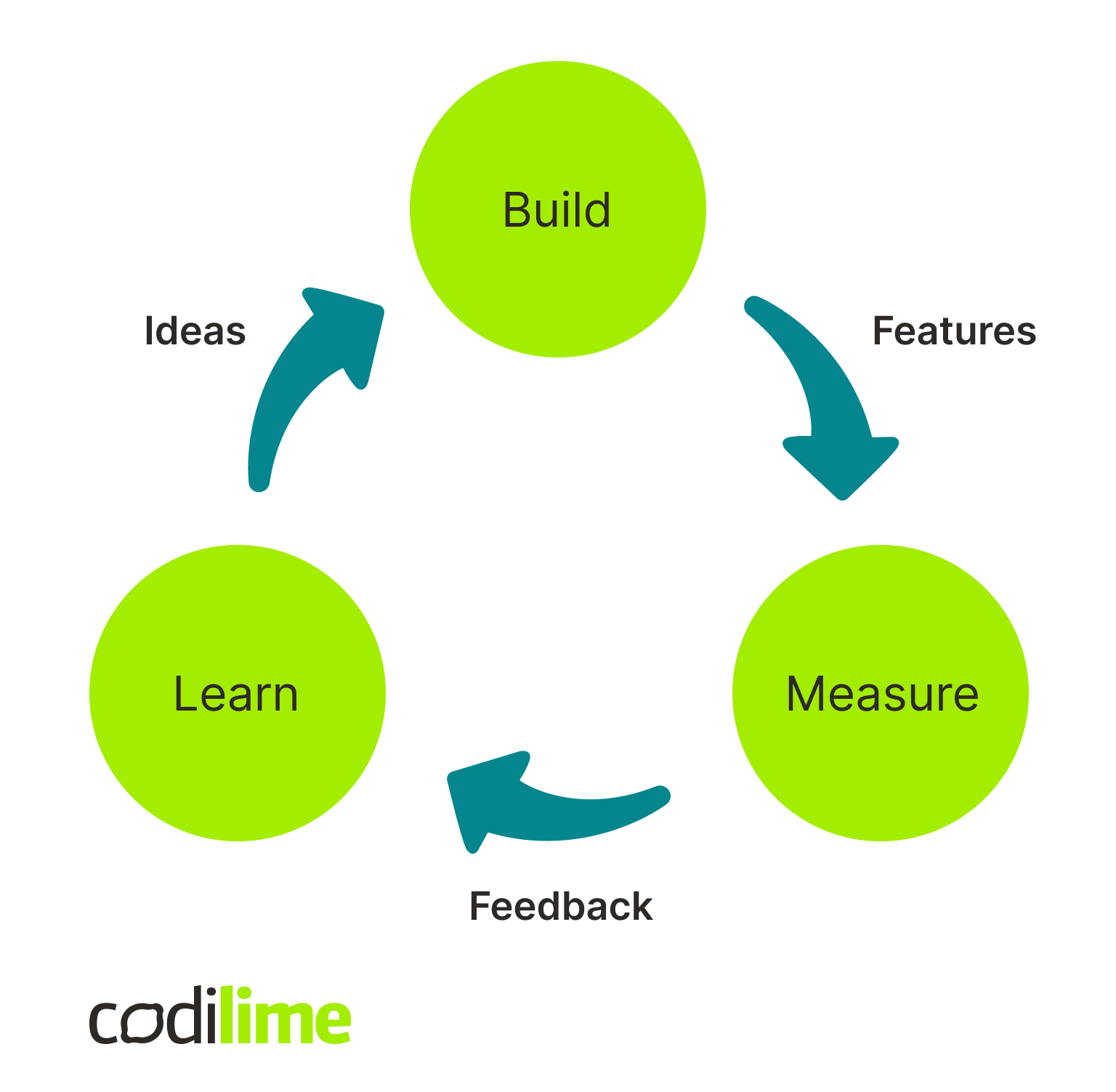A minimum viable product is a tool often used by startups to reduce the risk of overspending in the early stages of software product development. MVPs are popular because the success or failure of a product on the market may depend on its quality and implementation. How do you ensure that your product's MVP will fulfill its purpose and lead your team to success? The answer is an error-proof plan. Find out everything you need to know about a minimum viable product and how to create and use an MVP roadmap to build a scalable, robust software product.
What is an MVP?
MVP stands for a minimum viable product. It's the first version of a software product, and its purpose is to test the viability of the idea for the product. Its main characteristic is that a minimum viable product contains the absolute minimum of features - just enough to see how the product performs on the market.
The whole point of creating a minimum viable product is to investigate the product’s potential value with as little development effort as possible. It is an opportunity to test how the product performs in the real world and how first users respond. A minimum viable product is also the least costly way to do this. Launching a fully developed product requires too much time and effort and doesn't leave room for improvement.
Launching an MVP is a verified way of testing the product’s viability from a business perspective. Some of the most successful software products started as minimum viable products. One of the best-known examples is Instagram. The photo-sharing app that now is a profitable social media and e-commerce platform started as a location-based application for checking in and connecting with people. When the owners discovered that the demand for sharing pictures was ever-growing, they added features like likes, comments, and a photo editor.
Using the MVP approach allowed the Instagram owners to check their product's business potential without significant financial input. Developing the app further with each iteration and gradually adding new features led them to great success, ultimately selling the app to Facebook for a billion dollars in 2012. It was all possible thanks to the benefits that the MVP brought them.

Key benefits of an MVP
Implementing an MVP can profit a startup in many ways. While owners often focus on the financial benefits, it also improves the whole process of software development and provides precious data about customer behavior. Here's a list of reasons why a minimum viable product should be important to every startup.
- An MVP cuts spending
When the first version of the product only contains the necessary features, the team can use customer feedback to decide on what to develop next. Sometimes a functionality considered essential in the concept phase turns out to be not in demand. A minimum viable product ensures you don't waste time and money on such features.
- An MVP acts as a framework
This benefit is connected to the previous one. The feedback establishes the next steps of the product development process. Customer needs and behavior act as a guideline for further action. A minimum viable product also allows you to adjust the business direction early.
- An MVP is the most reliable form of testing
While tests can be (and should be) run at earlier stages of product development, a minimum viable product is the ultimate form of testing. It provides data on how the product performs in its natural environment and how first users respond.
- An MVP increases the product's credibility
Proving the business idea and market demand at an early stage increases stakeholders' trust. It makes your product more reliable and trustworthy, as the investors can already see whether there is potential for profit.
For a minimum viable product to bring these benefits, it must be developed with a proper strategy. You can read on our blog about the common mistakes to avoid while building an MVP and everything you should know about MVP software development. This time let's focus on the MVP roadmap - a step-by-step guide to developing a minimum viable product.
How to build a minimum viable product?
There are many approaches to building a minimum viable product. Choosing one should be based on your budget and the specific needs of the project or the team. Below you can find an essential guide to creating a minimum viable product. It's a flexible framework, so you can follow these steps as they are or adjust them to your product's requirements.
MVP roadmap
What is the problem to solve?
This step of the MVP development process is to identify the business or customer needs which will be the reason for your product to exist. They will be the business justification of the whole project. Be sure to write it down - it will be your guide in moments of doubt.
The problem to solve is also the long-term goal of your product. It should be measurable and specific. That's why you need to identify success criteria, which are metrics that show whether or not your product achieved its goal. While creating these criteria, you should ask yourself - at what point can the product be considered successful? Are you aiming for a specific number of monthly users or a fixed amount of money in transactions? There should be several success criteria - keep them achievable and specific.
What is your market?
Once you know what the goal of your product is and how you will measure its success, you should consider its environment. This step consists of market research. Check out your competition and think about how you're different from them - what would make the customer choose you instead of an already existing solution? The software market is quite saturated. That's why you need an added value that will draw users in.
This value is your key benefit. Focus on it when thinking of marketing your product and talking to investors.
Who are the users?
At this point, you probably have some ideas about who will use your product. You know their problems and other solutions they might have already used. This stage of the MVP development process is the time to dig deeper and think about who you want to target.
You probably will end up with several types of users. For example, on a hotel booking app, there would be two types of users - one group wants to book a hotel, and the other one is hotel owners. You should also divide them into smaller groups, considering their demographics or how they will use the product.
You will have assumptions about how each type of user will interact with your product. Write them down. Once you've launched an MVP, you can either prove these assumptions or see that they aren't true. This will help you decide what features to develop in the following steps.
How will they use the product?
To answer this question, you can use user story mapping. It’s a tool that helps you visualize the customers’ journey with your product.
To create a story map, think about what each type of user is trying to achieve with your product. For example, for someone using a hotel booking app, the end goal would be making a room reservation.
After identifying the end goal, which is also called a story ending, think about the actions the user has to take to complete their goal. For our example, the steps would be downloading the hotel booking app, creating a profile, searching for a hotel, comparing prices and locations, and booking the best room. The end goal (a wonderful vacation) is reached once these actions are concluded.
The sequence of actions leading to an end goal is called a user journey. It can be presented as a user journey map, which is a chart showing all these steps and their difficulty. Some steps will provide a positive user experience - these are the gain points. The other ones, where users encounter difficulties, are called pain points.
Gain and pain points help you decide which features can be improved later on. You should especially pay attention to the most difficult pain points. Translate them into "How might we" statements, for example, "How might we improve searching by location?". Write them down and come back to them with each iteration.
Which features are a priority?
At this point, you know your market, users, their needs, and user journey. With this information, you should be able to decide which features the MVP has to have and which can be added later on.
Prioritization is key here. Remember to reflect on the research you've already concluded and use that information. Create a breakdown of all the features you want to include in this product. Divide them into two categories: must-haves and nice-to-haves.
For example, in a hotel booking app, a calendar with available dates would be a must-have feature, but an algorithm suggesting similar offers would be nice-to-have and therefore not included in the minimum viable product.
You can also use tools that make decision-making easier, for example, a prioritization matrix, MoSCoW analysis, or the RICE method. Once you know which features to include in the first version of your product, you can proceed to MVP development.
What can you improve?
After all the research and building, your MVP can finally see daylight. That doesn't mean that the job is done. Launching the minimum viable product is just the beginning, followed by further iterations and constant improvement.
It's essential to collect feedback from real-life users. People who use completely new products are usually early adopters - tech-savvy and curious customers who are the first to try out new technologies. Make sure to observe their behavior and ask for their opinion. This way, you can collect valuable feedback that will help you decide which features to develop next.
At this point, it's good to come back to previous steps and check in with your goal and success criteria. This will help you keep track of the product's progress. It is also a good time to validate your assumptions about your users and maybe update their user journey map.
MVP development process – what's next?
The main point of creating an MVP is testing your product's viability and measuring customer feedback. You learn which ideas to implement next from the data you've gathered. Then you build these ideas into features.

This is the cycle of constant improvement for your product based on a lean startup approach. Once you've added new functionalities, you come back to the beginning - you measure feedback, learn from it, build new features, and so on.
This way, with each iteration, you learn something new about your product and its users. As a result, your fully-fledged product will be entirely based on user needs.
>> Need support in building an MVP? Explore our MVP development services.
Conclusion
Building an MVP is just the beginning of the software development process. But this early stage sometimes determines whether the project will be a success or not. That's why it's good to take your time with it and conduct comprehensive research so that no resources are wasted.
Your users are a goldmine for data. Don't waste this potential - make sure to improve your product constantly. It's always good to come back to the earlier stages of the process and check on your goals and success criteria.





